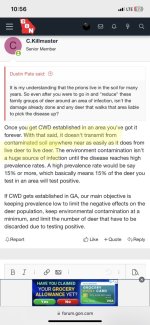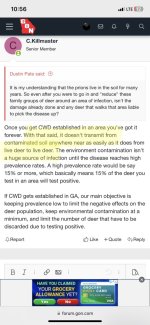Welcome Guest!
You are using an out of date browser. It may not display this or other websites correctly.
You should upgrade or use an alternative browser.
You should upgrade or use an alternative browser.
Ckillmaster's CWD Q&A thread
- Thread starter C.Killmaster
- Start date
C.Killmaster
Georgia Deer Biologist
Not one specific to CWD, but you can report sick deer to any Game Management Office during business hours or to our Ranger Hotline after hours. That's a great point though, we probably could do a better job telling folks how to report sick deer.If I come across a deer that looks like it may be sick how do I report it? is there a Georgia CWD hot line number or one planed?
1-800-241-4113
C.Killmaster
Georgia Deer Biologist
Without cleaning with bleach in between the prions have been shown to remain on knives and equipment. With that said, the miniscule amount likely represents very little risk. Untold numbers of CWD positive deer have been consumed by humans and there hasn't been a single case of it in humans thus far. I still wouldn't eat a deer that tested positive and if I had CWD in the county I hunt then I would test every deer I killed before feeding it to my family.If a processor uses a knife/equipment to process a deer with CWD and then uses that same knife/equipment to process my deer, does that run the risk of infecting my meat if the equipment has come in contact with contaminated brain or spinal parts?
bigchiefchoctaw
BANNED
@elfiii need to make this one a sticky
Are mineral licks/salt licks a bigger risk for spreading CWD than corn piles/feeders?
The same - bringing together deer unnaturally into a very small area where transmission of disease increases. So feeder of corn or salt lick - large number of animals on small source equals higher transmission rates.
I'll piggy back. Are those more of a concern than a natural water hole, a hot oak tree, a scrape/licking branch?Are mineral licks/salt licks a bigger risk for spreading CWD than corn piles/feeders?
I had far more deer visiting a hot scrape about 20 yards from a feeder than actually hit the corn itself back during the rut.
I agree licking branches.I'll piggy back. Are those more of a concern than a natural water hole, a hot oak tree, a scrape/licking branch?
I had far more deer visiting a hot scrape about 20 yards from a feeder than actually hit the corn itself back during the rut.
sprewett
Senior Member
@C.Killmaster really appreciate you taking the time to answer and educate us hunters on a not so great situation. Really appreciate it.
Can you post a picture of your biology degree?The same - bringing together deer unnaturally into a very small area where transmission of disease increases. So feeder of corn or salt lick - large number of animals on small source equals higher transmission rates.
If not, why not let the man with the actual degree respond to the questions, who is nice enough to have this Q&A, instead of answering from the peanut gallery.
Whitefeather
Management Material
In Indiana when you register a kill, there is an interactive map broken down by county and blocks in it that you must fill out as the exact location of the kill. Once that’s completed you can then take a volunteer questionnaire about signs of CWD. There is a 3 minute video to watch explaining how to spot the symptoms of CWD. It’s totally voluntary but, if you have a deer that shows signs of CWD, the state of Indiana knows where it is.My GON brethren, with CWD looming all around us you deserve honest answers from me, YOUR State Deer Biologist. List any questions you have and let's have a frank and honest discussion about them.
Also, bring me your convincing conspiracy theories about it, I ain't skeered!
Is anything like this available in Georgia or planned for Georgia?
sghoghunter
Senior Member
I'll piggy back. Are those more of a concern than a natural water hole, a hot oak tree, a scrape/licking branch?
I had far more deer visiting a hot scrape about 20 yards from a feeder than actually hit the corn itself back during the rut.
I would think not according to this comment but I may not be reading it right
Attachments
@C.Killmaster , Charlie, what are any telltale symptoms can we look for in the field for deer that will have CWD?
Thanks for this thread.
Thanks for this thread.
C.Killmaster
Georgia Deer Biologist
So in other words it’s better spread nose to nose rather than eating corn from under a feeder or out of a feeder where there isn’t nose to nose interaction.
There's a lot we still need to learn about transmission, but direct deer to deer contact appears to be more efficient. With that said there have been several studies that show that there is a lot more nose to nose contact at feeders or bait sites when compared to deer using food plots or random observations. No one can tell the degree to which putting out bait increases transmission rates, but it's a safe assumption that it doesn't help the situation. We obviously can't control all the behaviors that deer have that can transmit CWD, but we do have control over our own actions that may help it spread faster. Here is our current recommendation from our CWD information website:
Chronic Wasting Disease (CWD) | Department Of Natural Resources Division
- Feeding and baiting guidelines. Providing concentrated food sources that promote deer congregating in small areas increases the transmission of some diseases. Reducing or eliminating the use of feed or bait for deer may help reduce transmission of CWD. We strongly discourage trough feeders, gravity feeders, or piling feed up on the ground. Distributing the feed across a larger area may help reduce transmission by reducing the sharing of saliva by multiple deer. Limiting use of bait to just peak hunting times may also help.
C.Killmaster
Georgia Deer Biologist
Are mineral licks/salt licks a bigger risk for spreading CWD than corn piles/feeders?
I'm not aware of any research that would indicate one is worse than the other.
C.Killmaster
Georgia Deer Biologist
I'll piggy back. Are those more of a concern than a natural water hole, a hot oak tree, a scrape/licking branch?
I had far more deer visiting a hot scrape about 20 yards from a feeder than actually hit the corn itself back during the rut.
There are ongoing research projects in other states attempting to answer those questions, but it's difficult to tease apart. The main goal to is reduce risk for something we can choose not to do, not eliminate all risk of transmission.
C.Killmaster
Georgia Deer Biologist
They have found the prions in scrapes and on licking branches in areas with CWD. One thing I found surprising is that they tested a bunch of scrapes/licking branches in a part of Mississippi that has a high prevalence of CWD and only a portion of them had prions. My guess would have been that they would all be positive in a high prevalence area.I agree licking branches.
C.Killmaster
Georgia Deer Biologist
@C.Killmaster , Charlie, what are any telltale symptoms can we look for in the field for deer that will have CWD?
Thanks for this thread.
Hey Nick!
Most deer that have CWD don't have any symptoms yet because the incubation period is so long (18 to 24 months) and the symptoms don't start until near the end of that.
For deer that make it to that point they start to rapidly lose weight, have droopy ears, move slow and lack coordination, drool excessively, or walk in circles.
There are plenty of other diseases that share some of these symptoms, but we want hunters to report all sick deer to us.
C.Killmaster
Georgia Deer Biologist
In Indiana when you register a kill, there is an interactive map broken down by county and blocks in it that you must fill out as the exact location of the kill. Once that’s completed you can then take a volunteer questionnaire about signs of CWD. There is a 3 minute video to watch explaining how to spot the symptoms of CWD. It’s totally voluntary but, if you have a deer that shows signs of CWD, the state of Indiana knows where it is.
Is anything like this available in Georgia or planned for Georgia?
Not exactly like that, but we do encourage everyone to report sick deer to us and try to sample all of them for CWD. We also collect samples in every county each year and have done so for over 20 years. We've done a number of educational videos on our social media outlets too. That's an interesting way they have that set up, I'll have to check it out.


